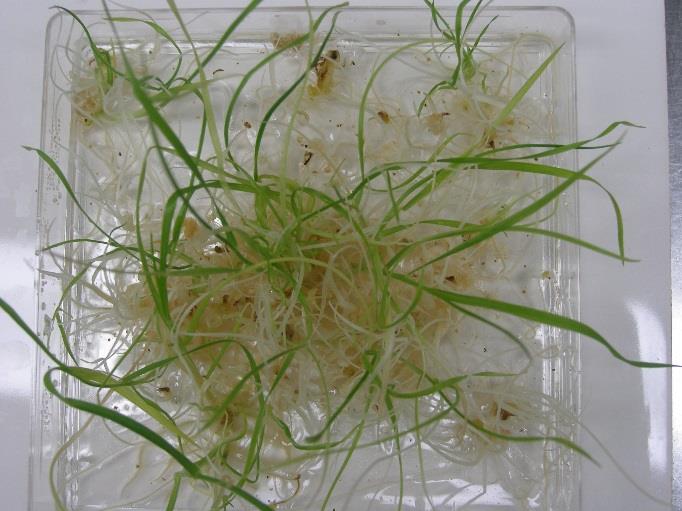Sagit.com.au

SAGIT Research Snapshot
S0311: Cost-effective doubled haploids for accelerating wheat and oat breeding
FAST FACTS
In a nutshell
The project successfully regenerated wheat doubled haploids
The details
using technology similar to that used for commercial barley
Start: September 1, 2011 Finish: August 30, 2014
breeding. This is the first time such high levels of regeneration
Project participants: SARDI - Dr Phil Davies, Dr
have been achieved using this method in Australia. The project
Parminder Sidhu.
also successfully regenerated oat doubled haploids at levels
The problem
far greater than previously achieved.
Doubled haploids (DH) plants can decrease the time to produce new varieties by three to five years, producing
However, these methods have been labour intensive
significant economic gains for the industry. Current
and costly, resulting in a reduction in the number of
methods are labour intensive and costly which has seen
doubled haploids used in wheat breeding. For oat
a decline in adoption of the technology.
breeding, doubled haploid technology is not yet
efficient enough for commercial use.
The research
The aim was to develop more efficient and cheaper methods for doubled haploid production in wheat and
oats using the isolated microspore culture (IMC)
RESEARCH AIMS
technique. For wheat, the aim was to develop a method
This project aimed to develop techniques to deliver
as efficient as that used for barley. For oats, the aim was
more efficient and commercially viable production of
to develop a method efficient enough to develop
wheat and oat doubled haploids.
doubled haploids for the National Oat Breeding
IN THE FIELD
During the course of the project, more than 4000
BACKGROUND
wheat spikes were cultured in experiments designed
Doubled haploid technology creates efficiencies in
to achieve maximum growth and plant regeneration.
plant breeding by bypassing the natural sexual
reproductive process. Wheat doubled haploids have
In addition, 4000 oat panicles were cultured in
been used since the mid-1990s, primarily using a
experiments designed to achieve maximum growth
technique crossing wheat and maize. Doubled
and plant regeneration.
haploid technology allows cereal varieties to be
released three to five years earlier than using conventional methods.
RESULTS
A method for doubled haploid production in wheat
Since 1997, seven barley varieties and 11 wheat
that produces plants at a similar frequency to the
varieties have been released by Australian doubled
barley method has now been successfully developed
haploid laboratories and breeding programs to
and two breeding populations have been provided to
deliver significant gains to the grain industry by the
breeding companies. For oats, the level of plant
early adoption of significant yield-bearing traits.

regeneration has been improved but is still only around 20% of the level for wheat and barley.
The level of spontaneous chromosome
doubling in wheat is 20%, which is much less than that of barley, which is around 70%. Therefore chemical doubling using colchicine is essential.
The costs of wheat doubled haploid
production using isolated microspore culture (IMC) were compared to the wheat x maize and the barley IMC method.
Wheat plants regenerating successfully from
The cost of a wheat doubled haploid plan
isolated wheat microspores
produced using IMC is around 45% of the cost of a wheat doubled haploid produced by
the wheat x maize method.
VALUE FOR GROWERS
The cost of a wheat doubled haploid
Improvements in plant breeding technology
produced using IMC is 15% higher than the
can lead to producing disease resistant
cost of barley because of the additional
varieties that require fewer fungicide
chromosome doubling step required.
applications, more weed-competitive varieties
that require less herbicide and varieties that
require less fertiliser inputs due to efficient
Barley ovaries significantly increased the
proportion of oat microspores that will grow
All of these outcomes can be accelerated
to form colonies.
through the use of doubled haploid
Consistent levels of plant regeneration are
not possible without the addition of 1%
Successful methods now exist for the creation
activated charcoal.
of wheat and barley doubled haploids for
There is a high level (85%) of spontaneous
commercial plant breeding.
doubling in regenerant plants.
Improvements have been made to the oat
doubled haploid technology but further work
Unfortunately, despite this project making significant
would be required to make this commercially
improvements to wheat and oat doubled haploid
technology, the benefits cannot be realised in the
Unfortunately, due to cost pressures, the
current economic climate. The economics of doubled
technology is unlikely to be adopted widely in
haploid implementation are no longer favourable.
the current climate. However, it has now been
However, two populations of IMC derived doubled
developed and is available should plant
haploids have been delivered to Longreach Plant
breeders choose to adopt it.
Breeders and Australian Grain Technologies. The methods developed in this project will be
More information:
published in scientific journals so they can be
Dr Phil Davies
implemented if the economic climate becomes
SARDI Senior Research Scientist
favourable for their adoption in future.
T: 08 8303 9494
E: [email protected]
SAGIT DISCLAIMER: Any recommendations, suggestions or opinions contained in this communication do not necessarily represent the policy or views of the South Australian Grain Industry Trust (SAGIT). No person should act on the basis of the contents of this communication without first obtaining specific, independent, professional advice. The Trust and contributors to this communication may identify products by proprietary or trade names to help readers identify particular types of products. We do not endorse or recommend the products of any manufacturer referred to. Other products may perform as well as or better than those specifically referred to. SAGIT will not be liable for any loss, damage, cost or expense incurred or arising by reason of any person using or relying on the information in this communication. CAUTION: RESEARCH ON UNREGISTERED AGRICULTURAL CHEMICALS USE. Any research with unregistered pesticides or of unregistered products reported in this communication does not constitute a recommendation for that particular use by the authors or the author's organisations. All pesticide applications must accord with the currently registered label for that particular pesticide, crop, pest and region. Copyright All material published in this communication is copyright protected and may not be reproduced in any form without written permission from SAGIT.
Source: http://www.sagit.com.au/wp-content/uploads/2014/07/S0311-Cost-effective-double-haploids-for-accelerating-wheat-and-oat-breeding-Phil-Davies-FINAL.pdf
apap.com.do
Informe Anual de Gobierno Corporativo 2008 Informe Anual de Gobierno Corporativo 2008 10 Órganos del Gobierno 26 Retos para el año 2009 A.- GOBIERNO CORPORATIVO EN APAP. La Ley Monetaria y Financiera No.183- 02, de fecha 21 de noviembre de 2002, introdujo importantes disposiciones relativas al sistema de gobernabilidad interna de las entidades de intermediación financiera. A partir
Microsoft word - screening neonatale. cart audiologia
La sordità infantile: lo screening uditivo neonatale universa- le, il percorso del paziente ipoacusico in età pediatrica. Alessandro Martinia, Paola Marchisiob, Luciano Bubbicoc, Patrizia Trevisia, Lodovico Perlettid a Dip. Neuroscienze e Organi di Senso – UOC Otochirurgia e Cattedra di Audiologia, Uni- versità di Padova b Professore Associato di Pediatria, Fondazione Ca' Granda Ospedale Maggiore Policlinico,